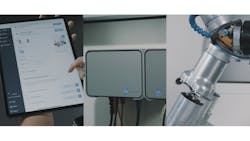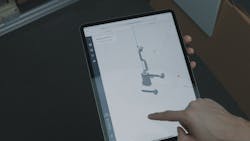Zero-programming deployment speeds collaborative automation
Robot programming has come a long way. There are various approaches, from hand-guiding all the way to platforms that achieve usability by eliminating programming altogether (Figure 1).
Zero-programming technology reduces the time and costs of deployment, lets integrators take on more projects with fewer experts and lets them pass ownership of the application and future changes to manufacturers, even if they don’t have experts in house (Figure 2).
Every improvement in the usability of collaborative automation, which includes both cobots and lightweight industrial robots, plays its part in reducing deployment lead times and costs. This enables integrators to take on more work and minimizes reliance on expert robot engineers to get applications up and running (Figure 3).
Manual labor shortages in the manufacturing sector are the number-one driver of industrial automation adoption. However, there are widespread shortages of robotics engineers and integrators, too, resulting in lost opportunities for both integrators and manufacturers.
Simplicity spurs cobot adoption
Collaborative automation in the form of cobots and lightweight industrial robots is a fast-growing segment of the industrial-robot market. Such systems are available to companies of all sizes, thanks to their affordability, fast return on investment (ROI), small footprint and ability to switch between different products and applications.
Collaborative automation, to varying degrees, breaks down the complexity of involving robotics engineers with in-depth knowledge of systems and programming languages via a range of usability features that enable companies with little or no previous robotics experience to deploy automation. Interfaces and programming techniques are not just a boon to end users: Integrators can benefit in numerous ways from technologies that are designed to reduce deployment lead times and costs. The culmination of these efforts in usability is fully automated deployment and programming, which frees integrators from a wide range of manual processes and provides a giant leap in usability that makes collaborative industrial automation deployments faster and easier than ever before.
Many cobot brands provide hand-guiding features designed to speed up the deployment process. Cobot users can program the system by guiding the robot and end effector into position by hand and setting various points along the way. This intuitive programming method saves time and money by reducing project complexity, but for non-experts it’s still difficult to know the most efficient and reliable path for the robot to take. Hand-guiding is an improvement, but some technical knowledge is still required to maximize performance.
Cross-platform systems enable speedy deployments across multiple cobot and light industrial robot brands. This “one system, zero complexity” approach supports programming across a wide range of robots and across a range of collaborative-application domains from screwdriving to pick-and-place operations. Providing a unified mechanical interface and communication standards across robot brands enables scalable automation expansion.
Limited programming required
Designed to enable easy deployments of collaborative systems, low-/no-code programming approaches use visual modeling and drag-and-drop user interfaces. Little programming knowledge is required to operate these systems, especially if the application is an extremely simple one. If, on the other hand, the application is complex, some programming knowledge is typically required to ensure a safe and successful deployment. Low-/no-code programming is an advancement, but for many subject-matter experts (SMEs) any programming at all can discourage investment in robotics.
Hello automated deployments
A technology platform can eliminate the need for programming altogether. This approach can automate the process of building, running, monitoring and redeploying collaborative automation, enabling complete applications to be deployed and redeployed directly on the manufacturing floor in a few steps with zero programming required.
The usability features we’ve looked at so far have been incremental, from better interfaces and more intuitive programming techniques to reduced programming requirements. The elimination of programming requirements is a completely different proposition.
This technology abstracts the programming details required for successful deployment such as path planning, program logic, signals exchange and event handling. The robotics expertise is built-in, so the user or integrator can define the cell boundaries and obstacles, and the software will produce an optimized program for the application.
Once the setup is completed, users click to run the application and can then monitor it in real time. Complete applications can then be developed and deployed on the factory floor.
Register for the conference at Automate Registration.
About the Author
Kristian Hulgard
Universal Robots

Leaders relevant to this article:




